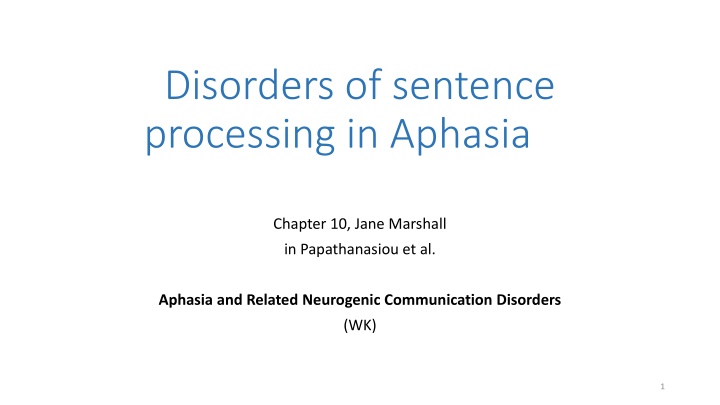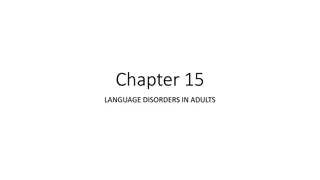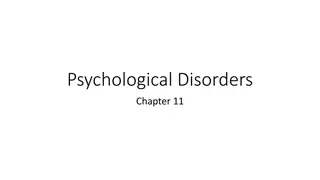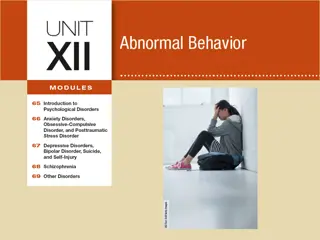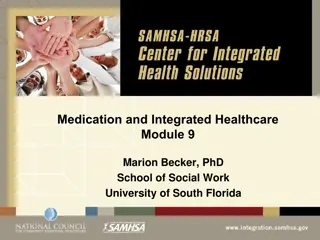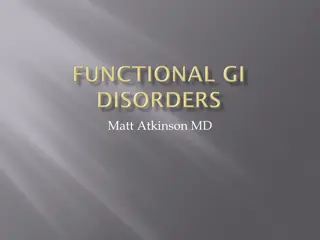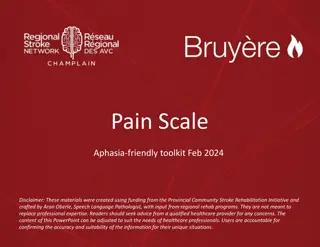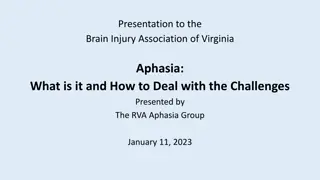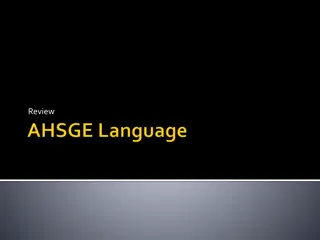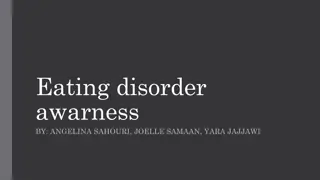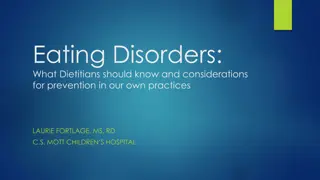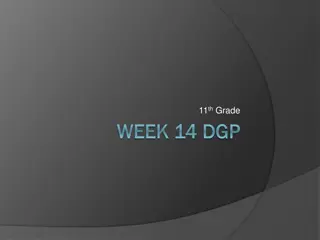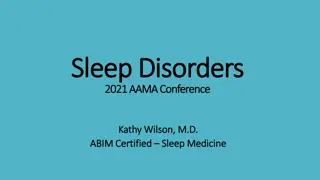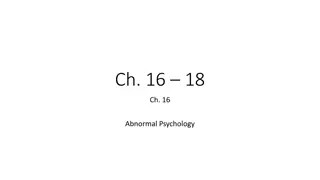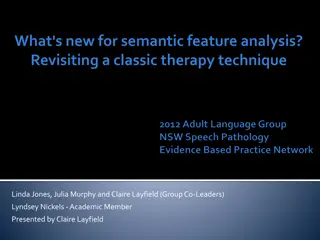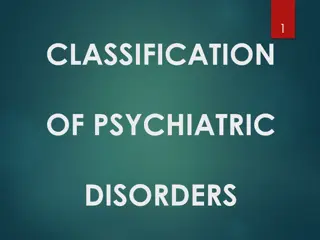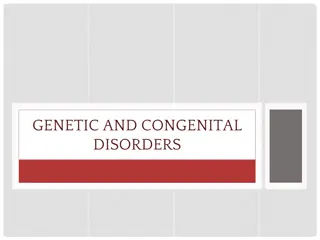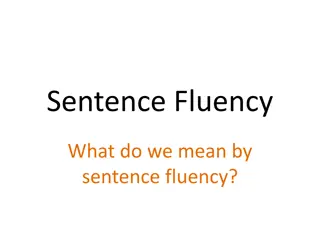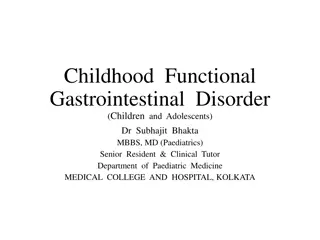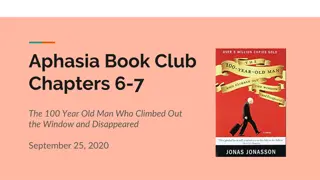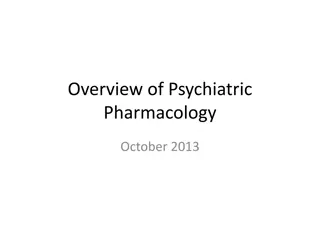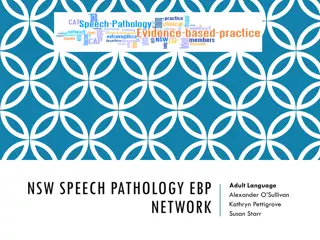Disorders of Sentence Processing in Aphasia
This chapter explores sentence processing disorders in aphasia, highlighting models like the Garrett Model and discussing deficits at the message level and therapy approaches. It delves into assessment tools, therapy strategies, and handling complex sentence structures in individuals with aphasia.
Download Presentation

Please find below an Image/Link to download the presentation.
The content on the website is provided AS IS for your information and personal use only. It may not be sold, licensed, or shared on other websites without obtaining consent from the author.If you encounter any issues during the download, it is possible that the publisher has removed the file from their server.
You are allowed to download the files provided on this website for personal or commercial use, subject to the condition that they are used lawfully. All files are the property of their respective owners.
The content on the website is provided AS IS for your information and personal use only. It may not be sold, licensed, or shared on other websites without obtaining consent from the author.
E N D
Presentation Transcript
Disorders of sentence processing in Aphasia Chapter 10, Jane Marshall in Papathanasiou et al. Aphasia and Related Neurogenic Communication Disorders (WK) 1
Garrett model (1988) Message Level (conception/event) Functional Level (semantic lexical selection, create predicate argument structure) Positional Level (phonological lexical selection, select planning frame) Phonetic encoding Articulation of the sentence 2
Deficit at Message Level? (event) Shown videos of events taking place and later results (e.g. a woman setting fire to a box and later things being burnt etc.) .Some subjects not sure who did what to which .(Marshall et al., 1993; 1995) Other naming studies show subjects get agency but don t structure key argument nouns around it very well (Cairns et al., 2007) 3
Therapy at Event Level? VERB: chase vs. flee Add video with perspective Perspective + language -- only this combo worked, with small effect (Cairns, 2006) 4
Therapy at Message Level #2? try structured therapy pointing out main event? Video clips of actions at 3 levels, subject makes decisions about agents and objects Slightly more successful, but only at two-argument events (Marshall et al., 1993) 5
Functional level ? (predicate argument structure) ASSESSMENT Verb and Sentence Test (VAST) 2002 PALPA (Psycholinguistic assessment of language in aphasia) 2002 6
Therapy for word order MAPPING THERAPY, via: Comprehension tasks (e.g., picture matching) Production tasks (help subjects compose word order) EVIDENCE? Not bad for same types of sentences For untreatedsentence types, not so good Might carry over to narratives, thus everyday life.. 7
What about more complex structures? TUF: Treatment of Underlying Forms (Thompson, 2008) Can handle, e.g. -wh questions (Whodid the boy pinch?) Clefts (It was the teacher who the boy pinched Obj. cleft, wh move) Passive (The teacher was pinched by the boy) 8
FUN!: https://www.youtube.com/watch?v=jY5wu9v2ypY TUF Thematic role training Sentence Building Thematic role training Practice EVIDENCE? Best generalization from complex simple, must involve similar operations Generally seems good? 9
Verb impairments Common problem for agrammatic aphasics Many reasons Complex argument structure makes it worse Also, imageability, information load 10
Therapy for verb impairments 1. Naming therapy techniques? (treated verbs improve, non-treated do not ) 2. Gesture therapy? (results don t seem very promising) 3. Emphasizing role of verb in a sentence (e.g., Bastiaanse et al., 2006) good results reported BUT gains typically confined to treated verbs no evidence that one approach is better than another 11
Impairments with grammatical morphology? WHAT DO WE TYPICALLY SEE? All little words omitted (freestanding and bound morphology) -- OR All syntactic markers eliminated Verbs more impaired than nouns Tense very vulnerable* (not sure WHY: Morphology? Phonology? Semantics?) Overuse of ing in English 12
Grammatical morphology ASSESSMENT NAVI (Northwestern Assessment of Verb Inflection) KGIT (Katz, Guataco Assessment of Verb Inflection) 13
Tense therapy? 1. (Mitchum and Berndt, 1994). n = 1. Pix of things about to happen, happening, completed. Reported good results. 2. Faroqi-Shah (2008) n = 4. Morphophonological (do these words sound the same? washes, washed?)and morphosemantic (Is this OK? Yesterday, the boy will wash his hands) conditions. Found morphosemantic treatment more encouraging.
Competence versus performance Competence not the problem, but performance ? EVIDENCE? Agrammatic subjects could carry out online syntactic priming tasks that they couldn t do offline Work of Kolk and others suggesting that given more time and less noise, agrammatic talkers could perform better THUS, ellipsis due to timing problems 15
Implications for assessment? Need to test for latent skills (e.g., repeating questions, using non-verbal stimuli, etc.) Determine extent to which subjects respond to cueing 16
Implications for therapy REST (Reduced Syntax Therapy) Springer et al., 2000 Encourages LESS morphosyntax, but word order structures of increased length Minimalism, economy of effort SENTENCE SHAPER (Linebarger and colleagues, 2000) Removes time constraints from productions 17
